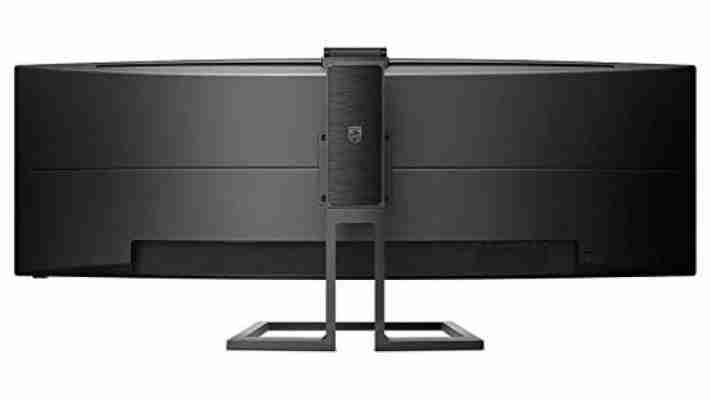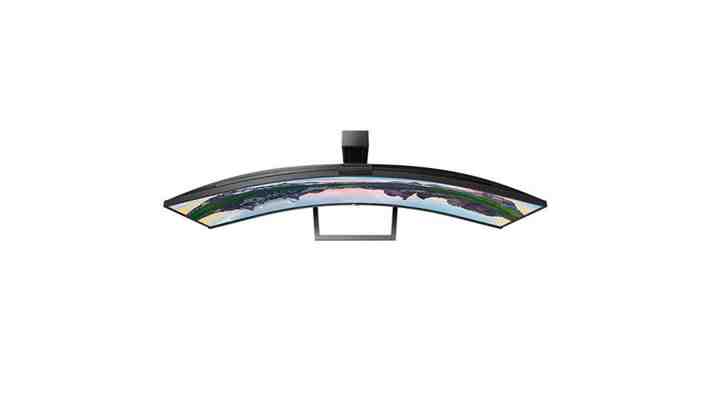Philips Brilliance 499P9H review: Outlandish beyond compare
The Philips Brilliance 499P9H is one of the most outlandish monitors we’ve ever seen. Its curved panel is designed for productivity, but at 49in diagonally with a 32:9 aspect ratio, it’s not exactly sober and sensible. Then again, Philips is angling it as a replacement for a dual-monitor setup, rather than just a show-off single screen. This is evident in the 5,120x1,440 resolution – the equivalent of two 2,560x1,440 displays side by side.
That’s a huge amount of screen real estate and, unlike with dual monitors, there’s no set of bezels running down the middle. You can even connect two PCs or laptops in order to run two devices using the same monitor, keyboard and mouse, thanks to a clever integrated KVM switch.
READ NEXT: Best monitor deals in the UK
Philips Brilliance 499P9H review: Design and setup
Get beyond its imposing design, however, and this monitor is a little more ordinary. The Brilliance 499P9H uses VA panel technology rather than IPS, and the screen is 8-bit colour rather than 10-bit colour. That means it can display 16.7 million rather than 1.07 billion colours, which rules out its usefulness for the most demanding design work.

The refresh rate, meanwhile, tops out at 70Hz, which is good for an office monitor but means there are better ultrawide options for gaming. This screen supports HDR, but it only uses the VESA DisplayHDR 400 standard. That’s one of VESA’s weaker standards, and it requires a burst brightness level of 400cd/m2, a prolonged brightness level of 320cd/m2 and a black point of 0.1cd/m2. Those are good figures for any normal screen, of course, but they’re not particularly outlandish for any screen at this sort of price.


Philips Brilliance 499P9H review: Features
The Brilliance 499P9H is a little inconsistent when it comes to features beyond the screen itself, too. For instance, it has three USB3.1 ports, a USB Type-C port and an Ethernet connector, which is great, but they’re all installed at the back and face downwards, which makes them tricky to reach, given the monitor’s size.
The two HDMI 2.0 ports and DisplayPort 1.4 connector are fine. So are the two 5W speakers: they provide enough quality and volume for casual media, even if the bass is a little too aggressive.

There’s a Full HD webcam that works with Windows Hello, and it can be hidden in the top bezel for privacy. It looks nice, too: it has slim bezels, subtle logos and a smart, minimalist metal stand that nonetheless offers good adjustability. There’s 130mm of height adjustment, alongside side-to-side swivelling and forwards and backwards tilting.
100mm VESA mounting is also supported, if you can find hardware that will support its 15.3kg weight. This heaviness also makes it harder to stand to keep everything steady, and as such it’s quite easy to make the screen wobble.
READ NEXT: Best monitors you can buy
Philips Brilliance 499P9H review: Performance
It’s at least easy to use the onscreen display (OSD). It’s well organised and is navigated by a row of small, snappy buttons beneath the bottom bezel, with mode-switching and input- switching options on several of the buttons. Performance testing also reveals some good news.
Colours are accurate, with an average delta-E of just 1.6 in Office mode, and if you switch to sRGB mode this improves even further to 1.1. A black point of 0.19cd/m2 and contrast ratio of 2,126:1 are even more impressive, and the peak brightness of 405cd/m2 is fantastic for a desktop monitor as well, not to mention enough to meet the VESA DisplayHDR 400’s criteria.
Lastly, we measured the Brilliance 499P9H covering 99.8% of the sRGB gamut, which is high enough to handle the demands of mainstream colour work and together with the high contrast ratio delivers excellent vibrancy. Unfortunately, while the Brilliance 499P9H excels in places, it falls short in others.
Despite its high sRGB coverage it could only manage 87.4% of the DCI P3 colour gamut, which is used for creating HDR content, and the sheer size of the panel meant it clearly struggled to maintain brightness uniformity.
The screen lost 32% of its backlight strength in the top-left corner, 30% in the top-right corner, and 17% and 22% across the top edge. At the bottom of the screen, meanwhile, the backlight weakened by 20% in the left corner and 24% in the right corner.
Philips Brilliance 499P9H review: Verdict
The huge width and resolution of the Brilliance 499P9H are undoubtedly a boon for plenty of work scenarios: there’s lots of space for applications, and it will be easier to work on this panel than on an inconsistent multi-monitor setup. You get good USB connectivity, a surprising amount of adjustment and a fast, navigable OSD.
In many key areas, however, Philips’ vast display doesn’t match more conventional monitors: you’ll get better colour accuracy and gamut coverage from the Samsung CF791, for example. What’s more, the Brilliance 499P9H’s HDR support is entry level, and its poor uniformity hampers its ability for complex, colour-sensitive work.
| Philips Brilliance 499P9H specifications | |
|---|---|
| Screen size | 49in |
| Resolution | 5,120x1,440 |
| Screen technology | VA |
| Refresh rate | 70Hz |
| Video inputs | HDMI, Display port |
| Warranty | Three years RTB |
| Details | https://www.philips.co.uk/ |
| Part code | 499P9H/00 |